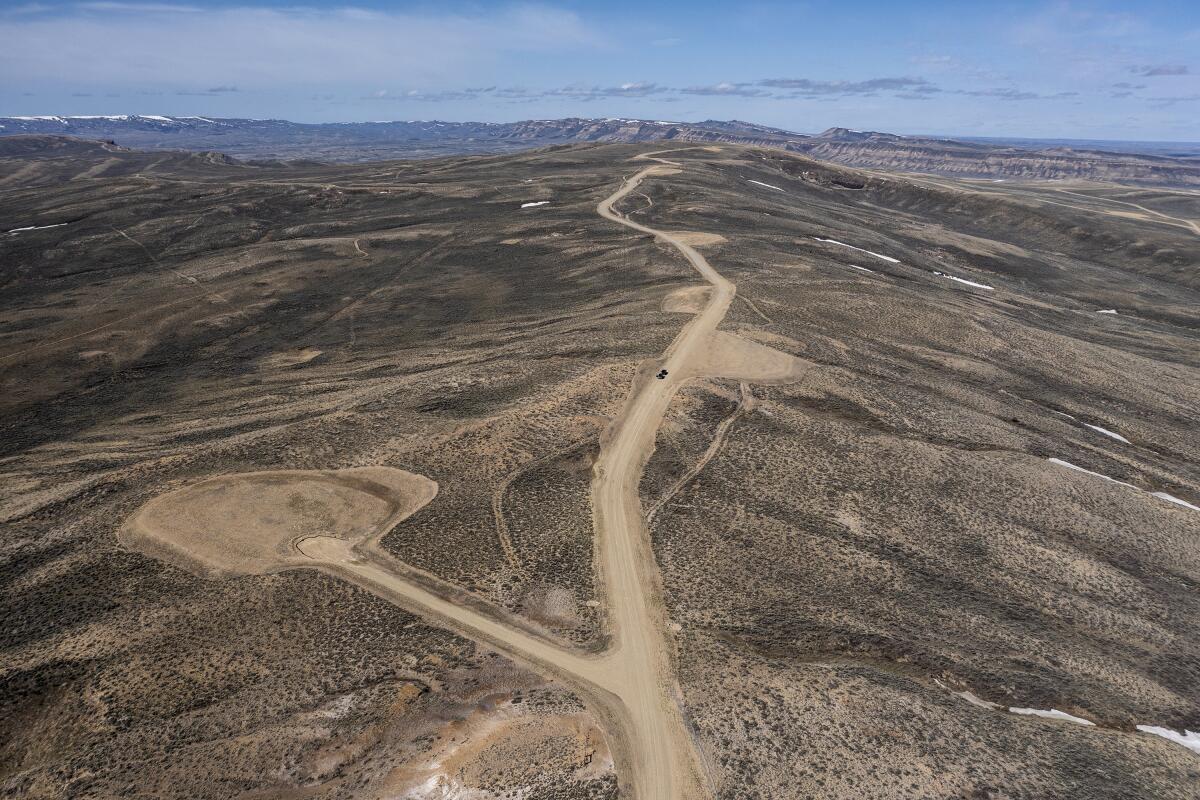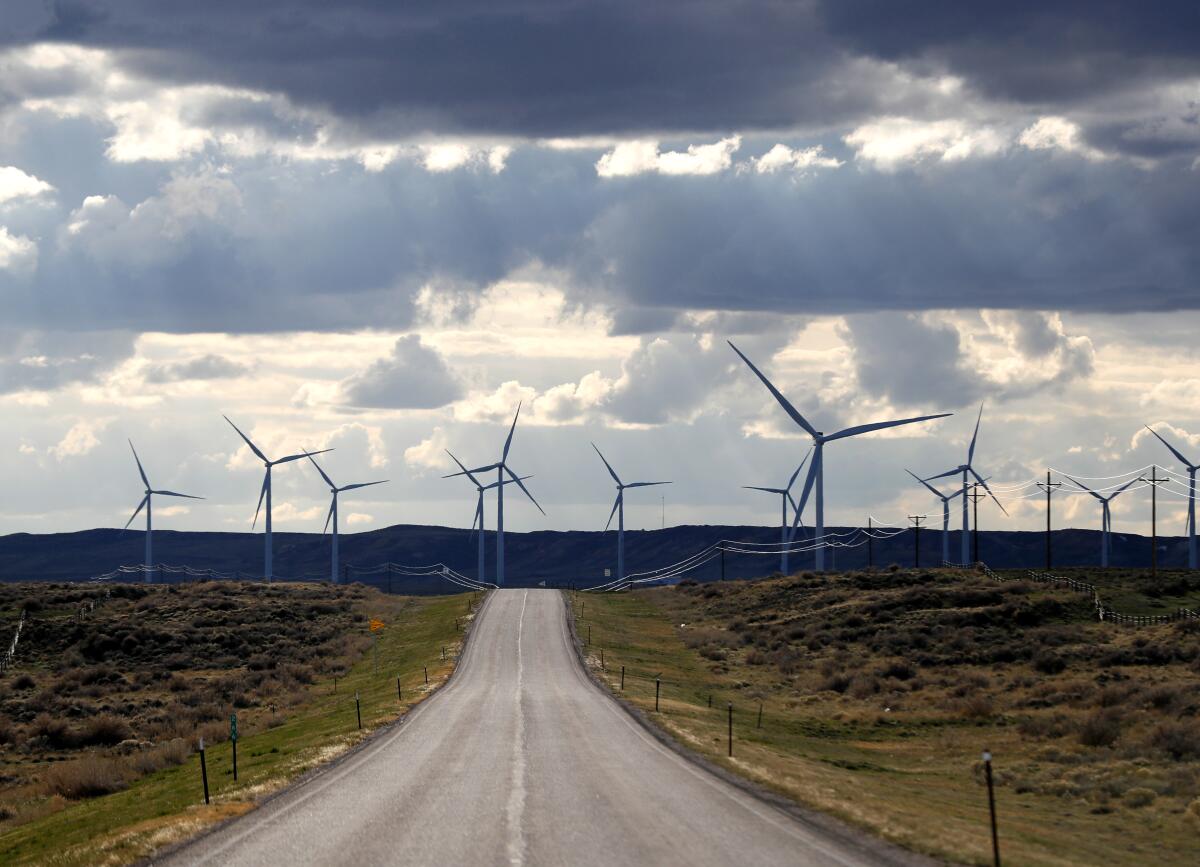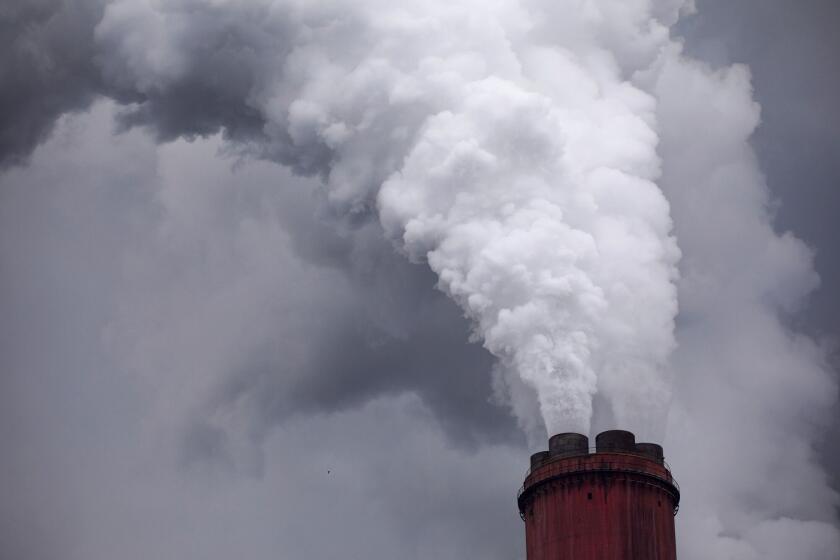Conservative billionaire pitches massive gas plant to power data centers

- Share via
Donald Trump had just been elected president when I first visited the sprawling Wyoming ranch of conservative billionaire Phil Anschutz in late 2016.
But my tour guides didn’t let President Trump’s well-known disdain for wind power stop them from sharing their story: With Anschutz’s fortune behind them, and huge profits ahead, they were preparing to build America’s largest wind farm. America’s future was renewable.
When I visited again in 2022, their story was the same: Wind turbines, all the way.
Not anymore.
After Trump returned to office this year and began weaponizing federal departments against clean energy, wind in particular, with a vengeance unlike anything seen during his first term, Anschutz’s Power Co. of Wyoming updated its website. The company now planned to build a gas-fueled power plant as large as 3,200 megawatts, it said in February. That would be the country’s second-largest gas plant, after a facility in Florida.
Anschutz’s 3,550-megawatt wind farm remained under construction, as did a long-distance power line capable of transmitting the electricity to California. But the way the company described its mission had changed.
Until at least Feb. 11, the website’s home page, as documented by the Internet Archive, was titled, “Putting wind to work for Carbon County.” It said the wind farm’s benefits would include “a reliable, competitively priced supply of renewable electricity” that would “help America reduce greenhouse-gas emissions.”
Now the page says nothing about heat-trapping emissions or renewable electricity, and little about wind. Instead, it’s littered with Trump-esque language about “American-made energy” and “electricity that our nation needs.”
There’s still a separate section of the site describing the wind project and its benefits. But atop the home page, a banner that previously featured two pictures — one of wind turbines, one of the U.S. flag and the Wyoming state flag fluttering in the wind — has been updated. In place of the flag picture, there’s a gas plant.
Why might an energy company owned by a Republican mega-donor feel the need to make such a pivot?

Simply put, Trump despises wind turbines, an obsession that dates to the early 2010s, when he tried and failed to block an offshore wind farm he believed would ruin the view from his Scottish golf resort. In January, he issued an executive order blocking construction of Lava Ridge, an Idaho wind project approved by the Biden administration. Trump’s appointees have paused federal permitting for all wind farms, which experts say is most likely illegal.
In their most brazen attack yet, last month Trump’s appointees ordered the Norwegian company Equinor to stop construction of Empire Wind, an ocean wind farm off the coast of Long Island that will help power New York City. The company had already invested $2.7 billion in the project. Until the Trump administration lifted the stop-work order this week, Equinor executives said they were days away from canceling Empire Wind entirely.
Given those events, it’s possible Anschutz’s pivot toward gas is a “strategic play” to avoid incurring Trump’s wrath, said Leah Stokes, an associate professor of climate and energy policy at UC Santa Barbara.
“Trump has been attacking wind so much,” she said.
Anschutz spokesperson Kara Choquette gave me a different explanation for the company’s gas-plant plan — one that had nothing to do with Trump. She cited “unprecedented demand growth,” alluding to the rapid adoption of artificial intelligence technology that’s driving a data-center boom — and a corresponding need for electricity.
“Market demand has always been the driver for our projects,” Choquette said via email.
In a filing with Wyoming regulators, the Anschutz Corp. expressed interest in selling power to “hyperscale data centers” that could be built on its Wyoming ranch. That power could come from the wind farm, the gas plant or a 1,000-megawatt solar farm that Anschutz is also interested in constructing.
A mix of wind and gas, Choquette told me, “will provide firm, reliable power at a meaningful scale and size.”

But Stokes, who helped craft portions of President Biden’s climate law, the Inflation Reduction Act, wonders if the gas plant proposal is largely performative. A surge in gas-plant construction, fueled by AI demand, has led to long delays for gas turbines. The research firm Wood Mackenzie reported this month that some energy developers are finding the earliest they can bring new gas plants online is 2030. Turbine costs have also hit all-time highs.
Meanwhile, solar and batteries made up nearly 84% of new power capacity built in the U.S. last year.
“You’ve got to build batteries and solar, because that’s the only thing you can build fast,” Stokes said.
Thus far, Anschutz’s company hasn’t applied for a gas-plant permit from Wyoming officials. But the Denver-based billionaire won’t lack for resources if and when he decides to move forward. He owns the Coachella music festival, the Los Angeles Kings and L.A.’s Crypto.com Arena, among other lucrative assets. He’s already spent at least $400 million over more than 15 years permitting and beginning to build the wind farm and 732-mile power line.
The wind farm and power line could help wean California off fossil fuels, supplying bountiful clean energy during the evening and nighttime hours, when solar panels stop generating and batteries aren’t always sufficient.
But if Anschutz does indeed build the nation’s second-largest gas plant, the air pollution could be significant.
Gas is usually cleaner than coal. But gas combustion still results in harmful pollutants, including nitrogen oxides, which the American Lung Assn. says can cause asthma attacks and reduced lung function. Gas also fuels the worsening heat waves, wildfires and storms of the climate crisis, especially when it leaks from pipelines and power plants in the form of methane, an especially powerful heat-trapping pollutant.
Anschutz’s company says on its website that the gas plant will be “hydrogen-capable and carbon-capture-ready” — meaning the facility will be capable of eventually switching from gas to clean-burning hydrogen, and ready to add installations that capture heat-trapping carbon dioxide before it escapes into the atmosphere.

In theory, those are nice ideas. In practice, both technologies mostly don’t exist yet in commercial, reliable form. Hence the “capable” and the “ready.” A 3,200-megawatt gas plant would be a big polluter.
“There are water issues. There are wildlife issues,” said Rob Joyce, director of the Sierra Club’s Wyoming chapter. “Even if it is on private land on their ranch, it’s something we should be concerned about.”
Shutting down all gas plants isn’t realistic, at least not yet; even California still depends on gas for one-third of its electricity. But scientists say building new gas plants, especially in richer nations like the U.S., is incompatible with a safe future for human civilization. Not to mention financially questionable, when solar and wind are cheaper.
Here’s hoping Anschutz doesn’t actually build a giant gas plant.
Perhaps just as importantly, here’s hoping America’s most wealthiest and most powerful people and institutions stop caving to Trump’s diktats. Universities, Fortune 500 companies, marquee law firms, billionaires — do they really think if they just give Trump a splash of what he wants, he won’t ask for more? And then he’ll leave office peacefully, and democracy will be fine? And we’ll maintain a livable climate and functioning economy?
I can’t know for sure if Anschutz’s gas-plant proposal is designed to appease Trump.
But Power Co. of Wyoming has definitely undergone a rebranding since he took office.
On its profile page on social media platform X — where it’s long posted under the username “welovewind” — the company used to describe itself as a supplier of “diverse, high-capacity, reliable, ‘Made in Wyoming’ wind power to help meet region’s [renewable portfolio standard, greenhouse gas] and economic growth goals.”
Sometime between late January and early March, though, the description changed. Now it reads: “High-capacity, reliable, clean, ‘Made in Wyoming’ electric power to help meet diverse market demands and goals.”
ONE MORE THING

On this week’s Boiling Point podcast, I talk with Sadie Babits, a climate editor at NPR and author of the excellent new book, “Hot Takes: Every Journalist’s Guide to Covering Climate Change.” We talk about how reporters can do a better job tackling one of the biggest stories of modern times — and how news consumers can help them.
You can listen to my conversation with Sadie on Apple Podcasts, Spotify or YouTube.
This is the latest edition of Boiling Point, a newsletter about climate change and the environment in the American West. Sign up here to get it in your inbox. And listen to our “Boiling Point” podcast here.
For more climate and environment news, follow @Sammy_Roth on X and @sammyroth.bsky.social on Bluesky.
Correction: Last week’s newsletter used the wrong name for a nuclear plant in Washington state. It’s Columbia Generating Station, not Centralia. Centralia is a coal plant.
Toward a more sustainable California
Get Boiling Point, our newsletter exploring climate change, energy and the environment, and become part of the conversation — and the solution.
You may occasionally receive promotional content from the Los Angeles Times.










